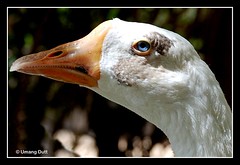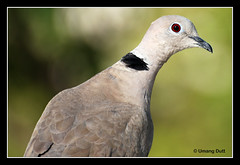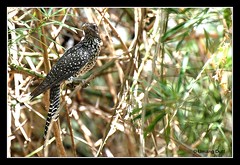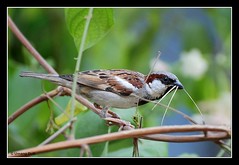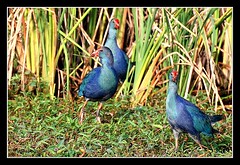The Swan Goose Anser cygnoides is a large goose with a natural breeding range in Mongolia, northernmost China, and southeastern Russia. It is migratory and winters mainly in central and eastern China. The species has been domesticated, and introduced and feral populations occur elsewhere.
It is large for its genus, 81–94 cm long (the longest Anser goose) and weighing 2.8–3.5 kg (the second-heaviest, after Greylag Goose). It has a long neck, long, heavy black bill, brown cap and pale underparts apart from some belly streaking; the upperparts are brown and the legs are orange. The sexes are similar, although the male is larger, and juveniles are duller. The voice is a loud honking. It grazes on sedges, and rarely swims. It forms small flocks outside the breeding season.
It is a rare goose of steppes and mountain valleys, which breeds near marshes and other wetlands, laying 5–8 eggs in a ground nest. In the winter it grazes on steppes and stubble, sometimes far from water.
The Swan Goose is extensively kept as poultry. A large number of breeds have been selected in captivity, known as Chinese goose (another heavier breed is known as the African goose, differing from the wild birds in much larger size (up to 5-10 kg in males, 4-9 kg in females), and in having an often strongly developed basal knob on the upper side of the bill. Some domesticated, introduced, or feral populations may be completely white, while others retain a plumage pattern more like wild birds. The knob at the top of the beak is more prominent on males than females. By 6–8 weeks of age, the knob is already pronounced enough that it can be used for sexing. A female Chinese goose can lay 50–60 eggs over the course of the breeding season (February to June), although there are reports of Chinese geese laying up to 100 eggs during that time.
"The hybrids from the common and Chinese geese (A. cygnoides), species which are so different that they are generally ranked in distinct genera, have often bred in this country with either pure parent, and in one single instance they have bred inter se." Charles Darwin, The Origin of Species, Penguin Classics
Sunday, April 27, 2008
Saturday, April 26, 2008
Eurasian Collared Dove, Streptopelia decaocto
The Eurasian Collared Dove, Streptopelia decaocto, also called the Eurasian Collared-Dove or simply the Collared Dove, is one of the great colonisers of the avian world. Its original range was warmer temperate regions from southeastern Europe to Japan. However, in the twentieth century it expanded across the rest of Europe, reaching as far west as Great Britain by 1953; breeding in Britain for the first time in 1956, and Ireland soon after. It also now breeds north of the Arctic Circle in Scandinavia. It is not migratory.
It was introduced into the Bahamas in the 1970s and spread to Florida by 1982. Its stronghold in North America is still the Gulf Coast, but it is now found as far south as Veracruz, as far west as California, and as far north as British Columbia and the Great Lakes. Its impact on native species is as yet unknown; it appears to occupy an ecological niche between that of the Mourning Dove and Rock Pigeon; some have suggested that its spread represents exploitation of a niche made available by the extinction of the Passenger Pigeon.
It breeds wherever there are trees for nesting, laying two white eggs in a stick nest. Incubation lasts 14-18 days, and young fledge after 15-19 days. It is not wary and is often found around human habitation.
This is a small dove, buff grey with a darker back and a blue-grey wing patch. The tail feathers are tipped white. It has a black half-collar on its nape from which it gets its name. The short legs are red and the bill is black. The iris is reddish brown, but from a distance the eyes appear to be black, as the pupil is relatively large and only a narrow rim of reddish-brown eye colour can be seen around the black pupil.
This is a gregarious species, and sizeable winter flocks will form where there are food supplies such as grain. The song is a coocoo, coo repeated many times. It is phonetically similar to the Greek decaocto ('eighteen'), to which the bird owes its name. Occasionally it also makes a harsh loud mechanical-sounding call lasting about 2 seconds, particularly when landing in the summer.
It was introduced into the Bahamas in the 1970s and spread to Florida by 1982. Its stronghold in North America is still the Gulf Coast, but it is now found as far south as Veracruz, as far west as California, and as far north as British Columbia and the Great Lakes. Its impact on native species is as yet unknown; it appears to occupy an ecological niche between that of the Mourning Dove and Rock Pigeon; some have suggested that its spread represents exploitation of a niche made available by the extinction of the Passenger Pigeon.
It breeds wherever there are trees for nesting, laying two white eggs in a stick nest. Incubation lasts 14-18 days, and young fledge after 15-19 days. It is not wary and is often found around human habitation.
This is a small dove, buff grey with a darker back and a blue-grey wing patch. The tail feathers are tipped white. It has a black half-collar on its nape from which it gets its name. The short legs are red and the bill is black. The iris is reddish brown, but from a distance the eyes appear to be black, as the pupil is relatively large and only a narrow rim of reddish-brown eye colour can be seen around the black pupil.
This is a gregarious species, and sizeable winter flocks will form where there are food supplies such as grain. The song is a coocoo, coo repeated many times. It is phonetically similar to the Greek decaocto ('eighteen'), to which the bird owes its name. Occasionally it also makes a harsh loud mechanical-sounding call lasting about 2 seconds, particularly when landing in the summer.
Friday, April 25, 2008
Indian flying fox (Pteropus giganteus)
Not exactly a bird but . . .
think its the PTEROPUS GIGANTEUS or the Indian Flying Fox
These animals can be found in forests and swamps. Large groups of individuals roost in trees such as banyan, fig, and tamarind. Roosting trees are usually in the vicinity of a body of water.
The physical appearance of this species is similar to that of megachiropterans in general, with large eyes, simple ears, and no facial ornamentation. Dark brown, gray, or black body color with a contrasting yellowish mantle is typical of the genus Pteropus. Body mass ranges from 600 to 1600 g and males are generally larger than females. Wingspan may range from 1.2 to 1.5 m and body length averages 23 cm. Members of the genus Pteropus maintain body temperatures between 33 and 37 C, but must do this through constant activity
This species is polygynandrous, with no pair bonds occurring between males and females. Females are defended from intruding males by males that live in their roosting tree.
Pteropus giganteus breeds yearly, with mating occurring from July to October, and births occurring from February to May. To initiate copulation, a male will fan his wings toward a female, and persistently follow her until he is able to grip the scruff of her neck with his teeth and hold her with his thumbs. Copulation occurs for a duration of 30 to 40 seconds. The female usually vocalizes and physically resists the advances of the male during the encounter. After copulation, the male again follows the female while vocalizing loudly. Gestation period is typically 140 to 150 days, after which 1 to 2 young are born. Like other members of the genus Pteropus, the young are carried by the mother for the first few weeks of life. Sexual maturity for this species occurs at about 1.5 years of age.After birth, young are carried by the mother for the first three weeks of life. They begin to hang by themselves after this time period, but are still carried to feeding sites by the mother. Young learn to fly at about 11 weeks of age and are weaned at 5 months. Males do not participate in parental care.
The longest lifespan of an individual of this species in captivity was recorded at 31 years, 5 months. Little information is available regarding life expectancy in the wild.
Pteropus giganteus is a social species, with large groups of several hundred individuals living in the same tree. Males may maintain a vertical dominance hierarchy of resting spots in the tree, and may also defend the roost and associated females from intruders. During the day, these animals sleep, hanging upside down by their feet with their wings wrapped around themselves. They also fan themselves to aid in thermoregulation, move around in the roosting tree, and communicate with each other. As they are nocturnal, they leave the tree at sunset to feed, returning after several hours of finding food, feeding, digesting, and resting.
The roosting tree is the area in which Indian flying foxes spend the majority of the day. This species, as well as other large species of Pteropus, is reported to travel up to 15 km to find food.
Communication among individuals of this species is vocal. They chatter and squawk when threatened. Typical of megachiropterans, P. giganteus does not echolocate, and relies on sight rather than hearing for navigation. Because of their use of vision, there is probably communication involving body postures and positioning. Tactile communication is important during mating, as well as between mothers and their offspring.
Pteropus giganteus is frugivorous, as are other species of the Suborder Megachiroptera, otherwise known as the Old World fruit bats. This species has been reported to eat many different species of fruit, including guava, mango, and fig. An individual of the genus Pteropus squeezes out fruit juices from the pulp against the roof of its mouth, and then discards the dry material. Some Pteropus species also supplement their dietary protein by eating insects. Others, including P. giganteus, eat the blossoms and nectar of fruiting plants
think its the PTEROPUS GIGANTEUS or the Indian Flying Fox
These animals can be found in forests and swamps. Large groups of individuals roost in trees such as banyan, fig, and tamarind. Roosting trees are usually in the vicinity of a body of water.
The physical appearance of this species is similar to that of megachiropterans in general, with large eyes, simple ears, and no facial ornamentation. Dark brown, gray, or black body color with a contrasting yellowish mantle is typical of the genus Pteropus. Body mass ranges from 600 to 1600 g and males are generally larger than females. Wingspan may range from 1.2 to 1.5 m and body length averages 23 cm. Members of the genus Pteropus maintain body temperatures between 33 and 37 C, but must do this through constant activity
This species is polygynandrous, with no pair bonds occurring between males and females. Females are defended from intruding males by males that live in their roosting tree.
Pteropus giganteus breeds yearly, with mating occurring from July to October, and births occurring from February to May. To initiate copulation, a male will fan his wings toward a female, and persistently follow her until he is able to grip the scruff of her neck with his teeth and hold her with his thumbs. Copulation occurs for a duration of 30 to 40 seconds. The female usually vocalizes and physically resists the advances of the male during the encounter. After copulation, the male again follows the female while vocalizing loudly. Gestation period is typically 140 to 150 days, after which 1 to 2 young are born. Like other members of the genus Pteropus, the young are carried by the mother for the first few weeks of life. Sexual maturity for this species occurs at about 1.5 years of age.After birth, young are carried by the mother for the first three weeks of life. They begin to hang by themselves after this time period, but are still carried to feeding sites by the mother. Young learn to fly at about 11 weeks of age and are weaned at 5 months. Males do not participate in parental care.
The longest lifespan of an individual of this species in captivity was recorded at 31 years, 5 months. Little information is available regarding life expectancy in the wild.
Pteropus giganteus is a social species, with large groups of several hundred individuals living in the same tree. Males may maintain a vertical dominance hierarchy of resting spots in the tree, and may also defend the roost and associated females from intruders. During the day, these animals sleep, hanging upside down by their feet with their wings wrapped around themselves. They also fan themselves to aid in thermoregulation, move around in the roosting tree, and communicate with each other. As they are nocturnal, they leave the tree at sunset to feed, returning after several hours of finding food, feeding, digesting, and resting.
The roosting tree is the area in which Indian flying foxes spend the majority of the day. This species, as well as other large species of Pteropus, is reported to travel up to 15 km to find food.
Communication among individuals of this species is vocal. They chatter and squawk when threatened. Typical of megachiropterans, P. giganteus does not echolocate, and relies on sight rather than hearing for navigation. Because of their use of vision, there is probably communication involving body postures and positioning. Tactile communication is important during mating, as well as between mothers and their offspring.
Pteropus giganteus is frugivorous, as are other species of the Suborder Megachiroptera, otherwise known as the Old World fruit bats. This species has been reported to eat many different species of fruit, including guava, mango, and fig. An individual of the genus Pteropus squeezes out fruit juices from the pulp against the roof of its mouth, and then discards the dry material. Some Pteropus species also supplement their dietary protein by eating insects. Others, including P. giganteus, eat the blossoms and nectar of fruiting plants
Thursday, April 24, 2008
Oh no not another Barbet !!
Loved the way it perched on the brach right in the opening ... used photoshop to remove the sky . . .
Leap of faith . . .
Another picture of one of my favourite birds .. the crimson breasted barbet as it lauches itself of a branch ... in B&W this time :)
Wednesday, April 23, 2008
Asian Koel (Eudynamys scolopacea) -femal
The Asian Koel (Eudynamys scolopacea), formerly also Common Koel, is a member of the cuckoo order of birds, the Cuculiformes, which also includes such birds as the roadrunners, the anis, and couas. It is found from southern Asia, China, and into Australia. The subspecies found in the Philippines is sometimes known as the Philippine Koel. Like many cuckoos, it lays its eggs in other birds' nests.
The word koel also means "nightingale" in India because of the Indian Koel's melodious call. It is also colloquially known as the Rainbird or Stormbird in eastern Australia, as its call is supposed to foreshadow rain.
The Asian Koel is a large, long-tailed, cuckoo at 45 cm. The male is bluish-black, with a pale green bill, rich red eyes, and grey legs and feet. The female is brownish above and whitish below, but is heavily striped and spotted brown on the underparts and white on the upperparts. She has an olive or green beak and red eyes.
Koels are very vocal, with a number of different calls.
The Asian Koel is a bird of light woodland and cultivation. It is a mainly resident breeder in tropical southern Asia from India and Sri Lanka to south China and Australasia. Birds at the fringes of the range, such as much of Eastern Australia, and on high ground are summer visitors, migrating to warmer areas in winter. They have great potential in colonizing new areas. They first arrived in Singapore in the 1980s and became very common birds
It is a brood parasite, and lays its single egg in the nests of a variety of birds, including the Jungle Crow, House Crow and various species of honeyeaters. In Sri Lanka it has been noted to parasitize only the Jungle Crow until the 1880 and only later shifted to the House Crow.May also parasitize Black-headed Orioles. The young Koel does not always evict its host's chicks, and initially calls like a crow. The adult koels however may not be leaving their offspring alone entirely:
The Indian koel (E. honorata) is the rain - bird of India. The bird is parasitic on crows, and it would appear from the notes of naturalists in India that the koels must look after their offspring to a certain extent, for they have been seen feeding their own young ones after they have left the nest.
The Asian Koel is omnivorous, consuming a variety of insects, caterpillars, eggs and small vertebrates. Adults predominanty feed on fruit. It has occasionally been known to take eggs of small birds.
The word koel also means "nightingale" in India because of the Indian Koel's melodious call. It is also colloquially known as the Rainbird or Stormbird in eastern Australia, as its call is supposed to foreshadow rain.
The Asian Koel is a large, long-tailed, cuckoo at 45 cm. The male is bluish-black, with a pale green bill, rich red eyes, and grey legs and feet. The female is brownish above and whitish below, but is heavily striped and spotted brown on the underparts and white on the upperparts. She has an olive or green beak and red eyes.
Koels are very vocal, with a number of different calls.
The Asian Koel is a bird of light woodland and cultivation. It is a mainly resident breeder in tropical southern Asia from India and Sri Lanka to south China and Australasia. Birds at the fringes of the range, such as much of Eastern Australia, and on high ground are summer visitors, migrating to warmer areas in winter. They have great potential in colonizing new areas. They first arrived in Singapore in the 1980s and became very common birds
It is a brood parasite, and lays its single egg in the nests of a variety of birds, including the Jungle Crow, House Crow and various species of honeyeaters. In Sri Lanka it has been noted to parasitize only the Jungle Crow until the 1880 and only later shifted to the House Crow.May also parasitize Black-headed Orioles. The young Koel does not always evict its host's chicks, and initially calls like a crow. The adult koels however may not be leaving their offspring alone entirely:
The Indian koel (E. honorata) is the rain - bird of India. The bird is parasitic on crows, and it would appear from the notes of naturalists in India that the koels must look after their offspring to a certain extent, for they have been seen feeding their own young ones after they have left the nest.
The Asian Koel is omnivorous, consuming a variety of insects, caterpillars, eggs and small vertebrates. Adults predominanty feed on fruit. It has occasionally been known to take eggs of small birds.
Tuesday, April 22, 2008
New bird discovered - long whiskered sparrow ?
Spotted this sparrow collecting straw to build its nest .. love the way it had the straws in its beak
The House Sparrow (Passer domesticus) is a member of the Old World sparrow family Passeridae, and is, somewhat controversially, considered a relative of the Weaver Finch Family. It occurs naturally in most of Europe and much of Asia. It has also followed humans all over the world and has been intentionally or accidentally introduced to most of the Americas, sub-Saharan Africa, New Zealand and Australia as well as urban areas in other parts of the world. It is now the most widely distributed wild bird on the planet
Wherever people build, House Sparrows sooner or later come to share their abodes. Though described as tame and semi-domestic, neither is strictly true; humans provide food and home, not companionship. The House Sparrow remains wary of man.
This 14 to 16 centimetre long bird is abundant in temperate climates, but not universally common; in many hilly districts it is scarce. In cities, towns and villages, even around isolated farms, it can be the most abundant bird.
The male House Sparrow has a grey crown, cheeks and underparts, black on the throat, upper breast and between the bill and eyes. The bill in summer is blue-black, and the legs are brown. In winter the plumage is dulled by pale edgings, and the bill is yellowish brown. The female has no black on head or throat, nor a grey crown; her upperparts are streaked with brown. The juveniles are deeper brown, and the white is replaced by buff; the beak is dull yellow. The House Sparrow is often confused with the smaller and slimmer Tree Sparrow, which, however, has a chestnut and not grey crown, two distinct wing bars, and a black patch on each cheek.
The House Sparrow (Passer domesticus) is a member of the Old World sparrow family Passeridae, and is, somewhat controversially, considered a relative of the Weaver Finch Family. It occurs naturally in most of Europe and much of Asia. It has also followed humans all over the world and has been intentionally or accidentally introduced to most of the Americas, sub-Saharan Africa, New Zealand and Australia as well as urban areas in other parts of the world. It is now the most widely distributed wild bird on the planet
Wherever people build, House Sparrows sooner or later come to share their abodes. Though described as tame and semi-domestic, neither is strictly true; humans provide food and home, not companionship. The House Sparrow remains wary of man.
This 14 to 16 centimetre long bird is abundant in temperate climates, but not universally common; in many hilly districts it is scarce. In cities, towns and villages, even around isolated farms, it can be the most abundant bird.
The male House Sparrow has a grey crown, cheeks and underparts, black on the throat, upper breast and between the bill and eyes. The bill in summer is blue-black, and the legs are brown. In winter the plumage is dulled by pale edgings, and the bill is yellowish brown. The female has no black on head or throat, nor a grey crown; her upperparts are streaked with brown. The juveniles are deeper brown, and the white is replaced by buff; the beak is dull yellow. The House Sparrow is often confused with the smaller and slimmer Tree Sparrow, which, however, has a chestnut and not grey crown, two distinct wing bars, and a black patch on each cheek.
Purple Swamphen (Porphyrio porphyrio)
The Purple Swamphen (Porphyrio porphyrio), also known as the African Purple Swamphen or Purple Moorhen or Purple Gallinule or Purple Coot , is a large bird in the family Rallidae. From its name in French, talève sultane, it is also sometimes known as the Sultana Bird.
Purple Swamphens are considered to be the ancestors of several island species including the extinct Lord Howe Swamphen and two species of Takahē in New Zealand. The Purple Swamphen itself, deriving from a later self-introduction, is a native of New Zealand, where it is called the Pūkeko. Its range is thought to have expanded there after the arrival of humans as the numbers of Takahē declined to near-extinction levels.
The Purple Swamphen prefers wet areas with high rainfall, swamps, lake edges and damp pastures. The birds often live in pairs and larger communities. It clambers through the reeds, eating the tender shoots and vegetable-like matter, they have been known to feed on invertebrates (like snails) and to rob eggs from nests and also eat ducklings. Sometimes they eat small fishes as well. They will often use one foot to bring food to their mouth rather than eat it on the ground. Where they are not persecuted they can become tame and be readily seen in towns and cities.
This species has a very loud explosive call, also described as a "raucous high-pitched screech, with a subdued musical tuk-tuk". It is particularly noisy during the breeding season. In spite of being clumsy in flight it can fly long distances, and it is also a good swimmer, especially for a bird without webbed feet.
The breeding habitat is warm reed beds across southernmost Europe, Africa, tropical Asia, and Australasia. The male has an elaborate courtship display,holding water weeds in his bill and bowing to the female with loud chuckles.[1]
Pairs nest in a large pad of interwoven reed flags, etc., on a mass of floating debris or amongst matted reeds slightly above water level in swamps, clumps of rushes in paddocks or long unkempt grass. Multiple females lay in the one nest and share the incubation duties, the nest is composed of grass or similar materials. Each bird can lay 3-6 speckled eggs - pale yellowish stone to reddish buff, blotched and spotted with reddish brown. A communal nest may contain up to 12 eggs, incubation period is 24 days.
Purple Swamphens are considered to be the ancestors of several island species including the extinct Lord Howe Swamphen and two species of Takahē in New Zealand. The Purple Swamphen itself, deriving from a later self-introduction, is a native of New Zealand, where it is called the Pūkeko. Its range is thought to have expanded there after the arrival of humans as the numbers of Takahē declined to near-extinction levels.
The Purple Swamphen prefers wet areas with high rainfall, swamps, lake edges and damp pastures. The birds often live in pairs and larger communities. It clambers through the reeds, eating the tender shoots and vegetable-like matter, they have been known to feed on invertebrates (like snails) and to rob eggs from nests and also eat ducklings. Sometimes they eat small fishes as well. They will often use one foot to bring food to their mouth rather than eat it on the ground. Where they are not persecuted they can become tame and be readily seen in towns and cities.
This species has a very loud explosive call, also described as a "raucous high-pitched screech, with a subdued musical tuk-tuk". It is particularly noisy during the breeding season. In spite of being clumsy in flight it can fly long distances, and it is also a good swimmer, especially for a bird without webbed feet.
The breeding habitat is warm reed beds across southernmost Europe, Africa, tropical Asia, and Australasia. The male has an elaborate courtship display,holding water weeds in his bill and bowing to the female with loud chuckles.[1]
Pairs nest in a large pad of interwoven reed flags, etc., on a mass of floating debris or amongst matted reeds slightly above water level in swamps, clumps of rushes in paddocks or long unkempt grass. Multiple females lay in the one nest and share the incubation duties, the nest is composed of grass or similar materials. Each bird can lay 3-6 speckled eggs - pale yellowish stone to reddish buff, blotched and spotted with reddish brown. A communal nest may contain up to 12 eggs, incubation period is 24 days.
Tuesday, April 1, 2008
Indian White-rumped Vulture (Gyps bengalensis)
The Indian White-rumped Vulture (Gyps bengalensis) is an Old World vulture in the family Accipitridae, which also includes eagles, kites, buzzards and hawks. It is closely related to the European Griffon Vulture (Gyps fulvus) though less so than it was long believed to the White-backed Vulture. Its alternate name, Oriental White-backed Vulture, is a leftover from that time.
It breeds on crags or in trees in northern and central India, Pakistan and southeast Asia, laying one egg. Birds may form loose colonies. The population is mostly resident.
Like other vultures it is a scavenger, feeding mostly from carcasses of dead animals which it finds by soaring over savannah and around human habitation. It often moves in flocks.
The White-rumped Vulture is a typical vulture, with a bald head, very broad wings and short tail. It is much smaller than European Griffon. It has a white neck ruff. The adult’s whitish back, rump and underwing coverts contrast with the otherwise dark plumage. Juveniles are largely dark.
Conservation status - CRITICALLY ENDANGERED
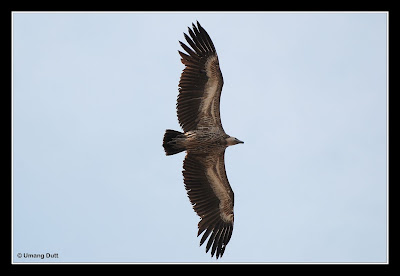
Conservation status - CRITICALLY ENDANGERED

Conservation status - CRITICALLY ENDANGERED

This is the smallest of the Gyps vultures, with 75-85 cm in length, and 4.75 kg in weight.
It breeds on crags or in trees in northern and central India, Pakistan and southeast Asia, laying one egg. Birds may form loose colonies. The population is mostly resident.
Like other vultures it is a scavenger, feeding mostly from carcasses of dead animals which it finds by soaring over savannah and around human habitation. It often moves in flocks.
The White-rumped Vulture is a typical vulture, with a bald head, very broad wings and short tail. It is much smaller than European Griffon. It has a white neck ruff. The adult’s whitish back, rump and underwing coverts contrast with the otherwise dark plumage. Juveniles are largely dark.
Conservation status - CRITICALLY ENDANGERED

Conservation status - CRITICALLY ENDANGERED

Conservation status - CRITICALLY ENDANGERED

This is the smallest of the Gyps vultures, with 75-85 cm in length, and 4.75 kg in weight.
Subscribe to:
Comments (Atom)


